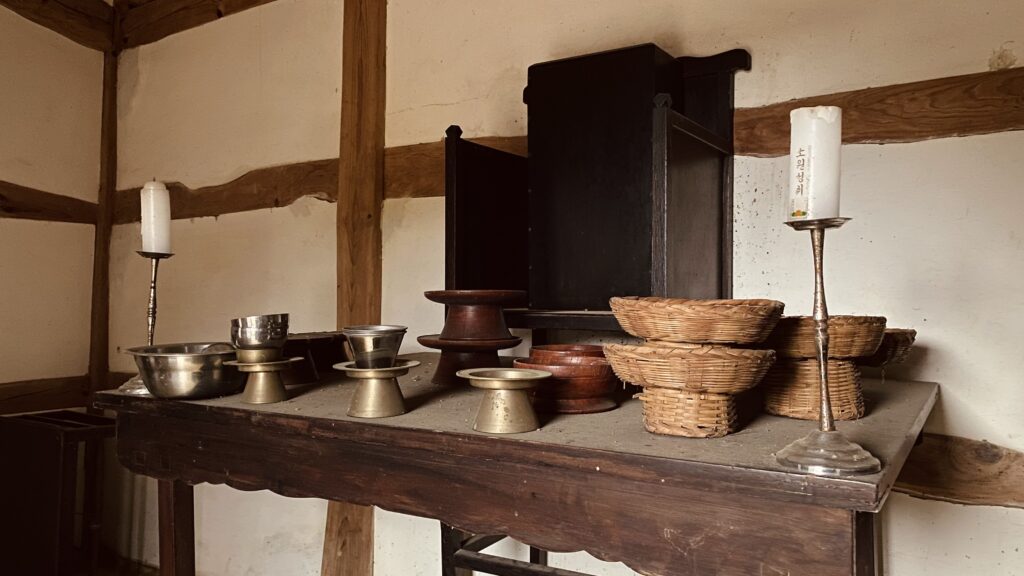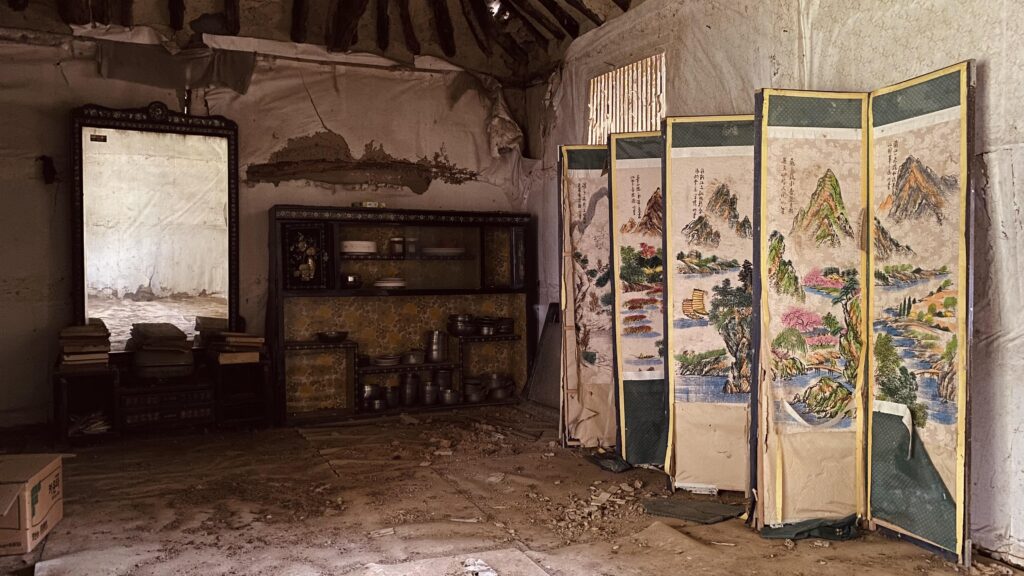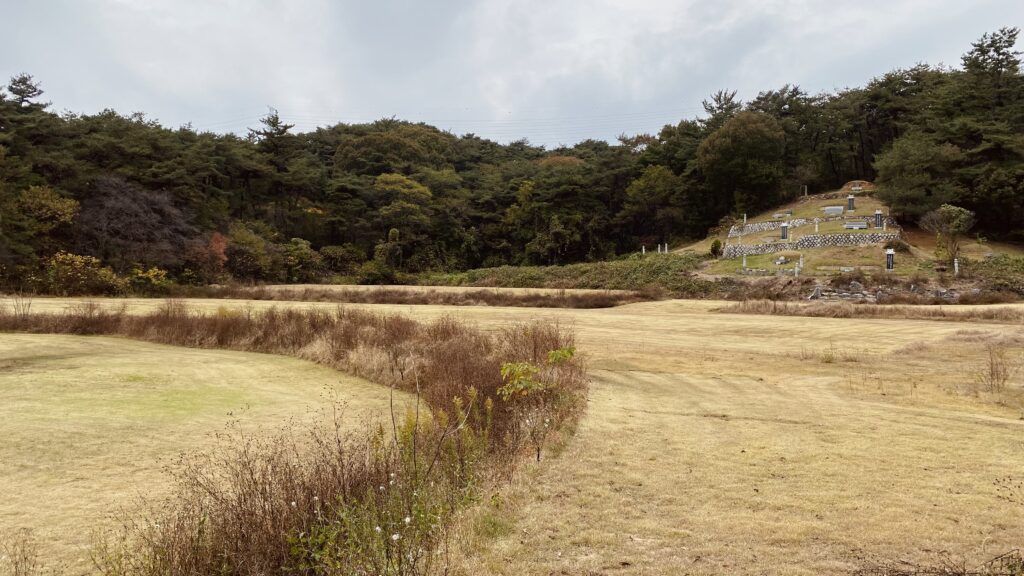Hidden Shrines of Gwangsan-gu
By Isaiah Winters
Along the hillocky western edge of Gwangju is the sadang archipelago. These sadang (사당), or ancestral shrines, pock the forests of pine and bamboo that every year inch toward reclamation. Dispersed along the hills’ narrow hollows, each sadang cuts a singular figure of idyllic isolation and semi-abandoned tradition that makes for poignant photography. While they may seem like islands unto themselves, the fact that there are no fewer than a dozen in this sleepy corner of Gwangju suggests they’re part of a network of sorts, not unlike an archipelago. So, in this rendering of “Lost,” we’ll peruse the hidden shrines of Gwangsan-gu to see what secrets they hold.
The Lone Shrine of Sarang-san
Believe it or not, Gwangju has a Sarang Mountain. It’s the penultimate peak just shy of the city’s western fringe and comes pitted with innumerable mudeom (무덤, burial mounds) connected by a well-maintained webwork of gently rolling trails. Surprisingly, there’s nothing “lovely” about its name, as its Chinese characters translate to “Lion Wolf Mountain” (獅狼山), which is also pretty cool. According to one source,1 the mountain’s shape was said to resemble a lion, and if you squint really hard – nope, it looks nothing like a lion. The same source said that this mountain was once where rain prayers took place during times of drought and that, consequently, no burial mounds could be put on the mountain or else a drought would ensue. Any graves had to be dug up by the local women, who sang and danced as they disinterred the corpses. These days, Sarang Mountain is covered with burial mounds and, interestingly, we’ve also been having prolonged droughts.
Along the southern edge of Sarang Mountain, where a long, single-lane concrete road weaves through tiered rice fields before dead-ending at the treeline, a secluded sadang sits nestled in a divot hewed from a thick patch of bamboo. I made my way there recently after finding it online and was pleased to see that it was in decent shape, meaning the family maintaining it still visits often enough. The thick perimeter walls were intact and offered a sturdy deterrent against trespassers, while the main gate was sealed with a hefty padlock. The wooden pillars all seemed to be in great shape, the roof showed no signs of collapse, and the white walls lacked any signs of water damage. Only its papered doors had become perforated with time, allowing in dust and bugs little by little. Still, this one is safe for now. As much as I like to enter places like this, seeing it well guarded and respected gave me hope that it’ll last a long time.
Sweeping a Stranger’s Home
Just north of Sarang Mountain is one particularly secluded building complex at the most attenuated top end of a long, winding hollow. This site is quite historically significant for being the home of Oh Hyo-seok (1620–1697), a mid-Joseon-era scholar who, in addition to deftly wielding an inkbrush, also wielded weapons of war against the Qing during their invasion of Joseon in 1636. Though the war resulted in a Qing victory that reduced Joseon to a tributary state, Oh survived and withdrew to this solitary hillside to live out the rest of his life in peace. According to one source,2 Oh built this residence along with a school in 1637 and spent the remainder of his life educating the local youth. Hundreds of years later, due to the site’s concealed location deep in the forest, soldiers from Korea’s “Righteous Army” (의병) garrisoned in the area and manufactured weapons there in their fight against invading Japanese forces until the end of the Joseon era.

I’d known of the site for some time but never bothered to visit until researching for this article, assuming until then that it was off limits for irregular visitors like me. To my surprise, the side gate was wide open and there weren’t any “No Entry” signs, so I wiped my boots and let myself in. I got another surprise when I saw that two of the main building’s doors had been left open, allowing in lots of dust and bugs. With nobody around to stop me, I removed my boots, picked up a broom and dustpan, and began sweeping the place out. Once that was all done, I arranged things inside so they didn’t look so disheveled and then continued to the porch to sweep that as well, filming a very satisfying timelapse of the entire process. In back of this main house is a shrine fully stocked with spirit tablets, candles, bowls, and stands ready for the next jesa (제사, ancestral rite). It was a really rewarding experience that connected me to the late Oh, though I’d probably have been better off just staying home and vacuuming my own place for the living who still inhabit it.

Beyond the Shrines
In addition to shrines, this entire western rim of Gwangju has other structures worth mentioning, like forlorn hanok and pavilions. One hanok that I got to see inside was incredibly picturesque despite (or maybe thanks to) its state of slow decay. An eight-paneled folding screen along one wall had the most vivid coloring I’ve ever seen, almost looking like it was made with bright acrylic paint rather than the usual muted tones seen on most folding screens. This screen led to a cupboard ornately trimmed with mother of pearl that stood beside a large vanity trimmed in the same fashion. The vanity came stacked with dusty old books that I couldn’t make heads or tails of, as they were all written in Chinese characters. The hanok’s exposed wooden beams above and crumbling mortar in between suggested this home wouldn’t stand much longer. I’m glad I got to capture its raw beauty before it inevitably collapses.

Besides structures, this area of Gwangju also has a uniquely rural charm that feels alien to the ever-expanding city restrained by Eodeung-san. One thing that’s salient about this rustic periphery is how local landowners are transforming fallow rice paddies into perfect grass fields once farming ceases. With an aging population and too few youths going into farming, something inevitably has to be done with these fields, lest they become nothing more than eternal breeding grounds for mosquitoes. Given the narrowness of all these little valleys and complex patchwork of land ownership, it’s hard to see the feasibility of a blanket buyout that results in more efficient, industrial-scale farming. Instead, many locals are filling them in and planting short, thick grass that practically begs you to organize a soccer match, play a game of tag, or even put up a tent and camp out for the night. I imagine many of Korea’s rice terraces will get the same treatment as the farming population continues to decline, and I think it’s going to be a beautiful transformation.

The Author
Hailing from Chino, California, Isaiah Winters is a pixel-stained wretch who loves writing about Gwangju and Honam, warts and all. He’s grateful to have written for the Gwangju News for over five years. More of his unique finds can be seen on Instagram @d.p.r.kwangju and YouTube at Lost in Honam.
Sources
1 Regional Cultural Exchange Honam Foundation. (n.d.). 역사문화자원 1000 [History and Culture Resources 1000]. http://gjstory.or.kr/sub.html?pid=48&formtype=view&code=81
2 Digital Gwangju Cultural Encyclopedia. (n.d.). 영사재(명도동) [Yeongsa Home (Myeongdo-dong)]. http://www.grandculture.net/gwangju/gwangsangu/toc/GC60001631







